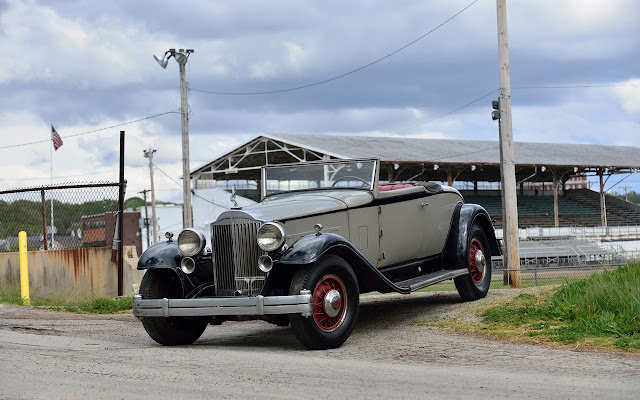1932 Packard Twin Six Roadster Coupe
- No. 579-63
- 1 of 311 Roadster Coupes produced
- Unrestored example
- First year for the reintroduced Twin Six, which was later renamed the Twelve
- 142.5" wheelbase Roadster Coupe 579 bodystyle
- 446/160 HP Twin Six engine
- Synchromesh 3-speed transmission
- Stromberg Duplex carburetor
- Red wire wheels with chrome hubcaps
- Rumble seat
- Red leather interior
- Waltham gauges, Swan hood mascot
- Golf club door, rear mounted spare
- Ride control with 3 adjustable positions for shock absorbers
- Freewheeling finger control on steering column
- Delivered new to Gene Meador Packard in San Antonio, Texas on August 6, 1932
- Purchased in 1951 from the original owner by the Kalinoff family of Mansfield, Ohio
- This car remained with the Kalinoff family until 2014
- Perhaps the only non-sidemounted 1932 Twin Six Coupe Roadster in existence
Packard developed its first 12-cylinder engines in 1915 in response to a challenge for supremacy by Cadillac, who had just switched from 4-cylinder engines to a new V-8. Known as the Twin Six, Packard’s V-12 overcame Cadillac’s daring gambit, reasserting its engineering supremacy and putting Cadillac in its place for the next decade. Packard had just reached its peak in 1928 when the Depression and Cadillac’s new V-16 combined to threaten the company’s prosperity. After two years of severely reduced profits and one year of operating losses, in 1932 Packard introduced a new V-12-powered line in hopes of reversing its fortunes. It did little for the company’s bottom line, but it became one of the greatest 20th century American classics.
During the development of the V-12, Packard considered a front wheel drive version that was strongly supported by the engineering team. Cornelius Van Ranst, who had been chief engineer on the Cord L-29, worked on a prototype with retired two-time Indianapolis 500 winner Tommy Milton under the guidance of Packard chief engineer Colonel J.G. Vincent. Insiders agreed that the car boasted exceptional design and engineering that likely would have found acceptance with the public. However, the many problems that bedeviled the L-29 resurfaced in the Packard prototype, and delays would have prevented a public demonstration before the 1932 model showings.
Disappointed but resolute in the face of huge financial pressures, Packard general manager Alvan Macauley insisted on conventional rear drive to keep the new Twin Six’s introduction on schedule. The 446 CI V-12 debuted in 1932 rated at 160 HP and a monstrous 322 lb-ft of torque, which launched the Packard V-12 with surprising power. Equipped with a single Stromberg Duplex carburetor and a 3-speed synchromesh transmission, a full size passenger sedan was clocked during a speed demonstration at 101 MPH, hinting at the performance available in the Roadster body style, which weighed 400 fewer pounds. In addition to the V-12, 1932 saw the introduction of Ride Control adjustable shock absorbers. The system was the inadvertent cause of some controversy when early production models arrived at dealers with an engraved plate over the dashboard mounted control button that read, “IN – HARD / OUT – SOFT.” A wave of indignation ensued, and the wording was quickly revised on subsequent cars. Another much less controversial new feature was a column-mounted button to actuate free-wheeling. In its final form the Packard V-12 was the second largest engine in any American car, placing ahead of Cadillac’s V-16 and behind the Marmon V-16.
Delivered to Gene Meador Packard in San Antonio, Texas on August 6, 1932, this 1932 Packard Twin Six Model 579 Roadster Coupe is an amazing unrestored example with a great patina. In 1951, the Kalinoff family of Mansfield, Ohio purchased the Packard from the original owner and cared for the car until 2014—a span of 63 years. Still finished in the original Grey with Black fenders and accents and Red wire wheels with chromed center caps, it retains the iconic swan hood mascot and features a rear mounted spare, rumble seat, golf club compartment and a stunning Red leather interior with Waltham gauges. Today this is one of the most desirable of the ten body styles offered on the 905 142.5-inch wheelbase chassis. This wonderful model survives as one of only 311 believed produced in 1932 and is perhaps the only non-sidemounted 1932 Packard Twin Six Coupe Roadster in existence today.

Comments
Post a Comment